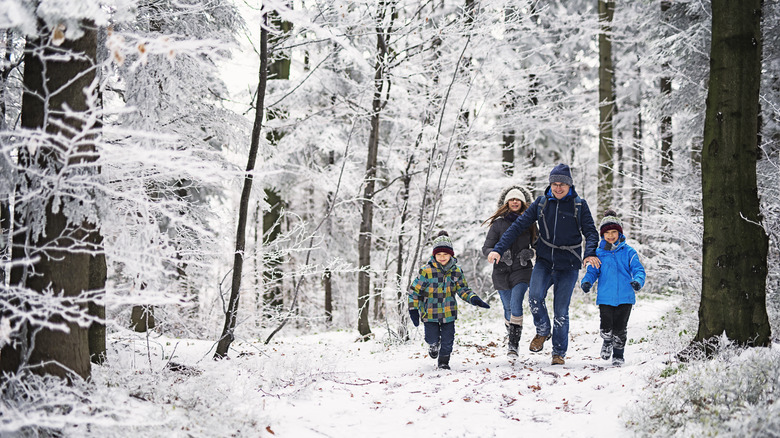One of the most romantic songs of the season is “Walking in a Winter Wonderland.” The lyrics tell the story of a couple strolling in the snow, dreamy and carefree, and by the end, you can easily imagine the footprints they’ve left in white bluffs. Truly, hiking in the snow can be scenic, rewarding, and healthy. Whether you’re meandering down snow-dusted paths in a city park or summiting a white-capped mountain in the Adirondacks, winter excursions are a special treat, especially if you have cabin fever and are just aching to get outside. Not sure where to go? We listed 12 underrated winter getaways across the United States.
Yet snowfall poses special challenges for hikers, and poor preparation can lead to discomfort, injury, or even worse. Nobody knows exactly how many people slip on the ice and break a bone each year, but according to the U.S. Environmental Protection Agency, more than 19,000 people died from “cold-related causes between 1979 and 2016.” Despite all our apps, YouTube tutorials, and polar fleece, cold weather remains an unforgiving force, and, understandably, many hikers prefer to go outside in any season but winter.
Don’t let statistics scare you, though. A few precautions go a long way, and a “snowy hike” can mean just about anything, as long as you’re walking over crystallized water under an open sky. The benefits of hiking in the darker months, such as circulation and mood enhancement, vastly outweigh the concerns. But if you’re hesitant to strap on boots and trek through nature in subfreezing temperatures, here are some basic tips to keep you comfy and safe.
Watch the weather forecast
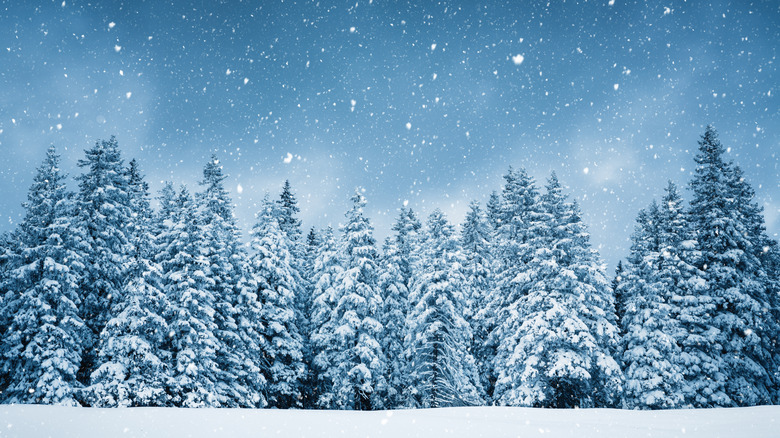
Before you figure out your route or even pick an outfit, check the weather forecast. Some inclement weather is obviously best avoided for its disastrous implications for hikers, like blizzards and extreme low temperatures. But while a strong wind might seem neglibile, it can have a daunting effect on winter hikers, too; windchill will make the air seem much colder than it is, and repeated blasts against exposed body parts can damage your skin. Any temperature above freezing will cause the snow to melt, which means wet (and perhaps muddy) conditions — and, depending on the water conditions in the hiking area, flooding. Snowfall can turn into freezing rain, which will soak through most winter gear and make you bitterly cold. Riskiest of all is hiking over frozen water, such as a pond or lake, which should only be done when the ice is four or more inches thick.
Conditions may also change over the course of hours, and a sunny midday hike will feel very different from a sub-zero midnight in a tent. New cold-weather hikers sometimes forget how early the sun can set in winter, and the combination of cold and darkness has proven dangerous for many outdoorspeople. This shouldn’t be a problem for day hikers with a few hours of free time, but if you’re feeling ambitious, make sure to check the weather report for the full duration of your trek.
Prepare for the type of snow
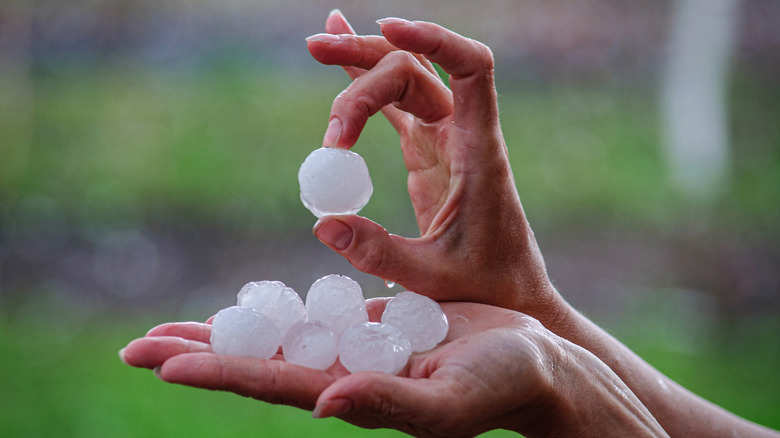
Anyone who lives in a wintery place knows that snow comes in many forms. Sleet, slush, hail, and powder all describe various types. In terms of its texture, snow can be grainy, crusty, and dusty. Snowfalls can vary in volume as well. The heaviest two-day snowfall in the United States took place in Thompson, Alaska, in 1955, and while most people will never see a dump of 120.6 inches, the states that get the most snowfall in the U.S. expect a foot or more with every storm.
Each type of snow will affect a hiker in different ways. Powder is pleasant to step through, but it can cake around clothing and make you cold. Icy snow tends to be slippery and hard to walk through, and you may find yourself cracking the crusty surface as you go. Melting snow can make hikers wet and muddy. Icicles may form in trees and along the edges of roofs, and people are frequently injured when they break off and fall. In mountainous backcountry, one of the biggest dangers you can encounter is an avalanche, and if you’re hiking on a glacier, there’s always the chance you will fall through into a hidden crevasse. If you’re new to snow, you’ll find yourself adapting to different conditions and needing to be extra safe when traveling to your hiking destination.
Wear waterproof boots
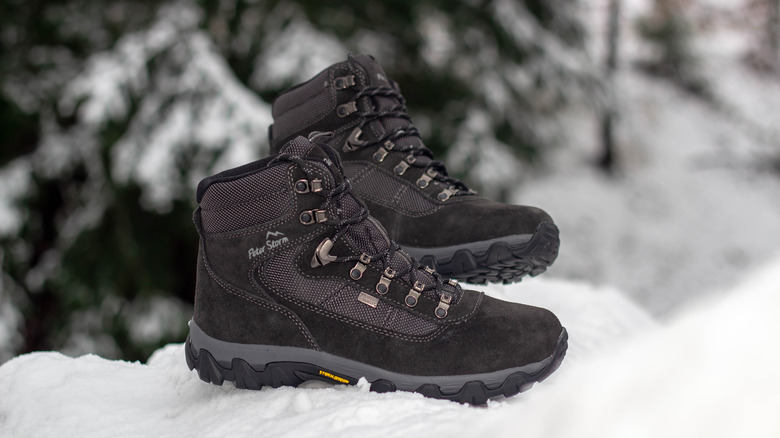
Juiced Up Media/Shutterstock
Wet feet will ruin a hike, no matter what season it is. In warmer weather, stepping in a puddle can result in wrinkled soles and blisters. In winter, wet feet can accentuate the feeling of cold. If your feet are critically moist, they will lose heat 25 times faster than when they’re dry. Breaking through a frozen puddle or letting too much snow sneak into your boot can ruin an outdoor excursion, especially if you’re covering a lot of ground or camping overnight.
Sturdy, waterproof hiking boots are your best bet. Gore-Tex is a well-known material for both keeping out water and letting vapor escape. Remember, hiking through snow is basically hiking through water, and the moisture and cold can sneak up on you. Thick socks are also a wise choice, ideally made from real wool, which both cushions feet and keeps your skin dry. Avoid cotton socks, which retain moisture.
Use gaiters
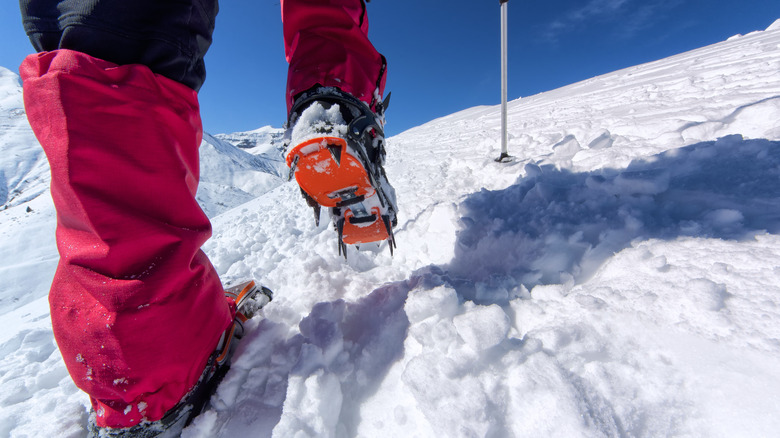
Fabernova/Getty Images
A gaiter is a piece of fabric that wraps around your ankle and shin. One of the simplest forms of clothing you can buy, nylon gaiters can make all the difference on the trail: They’re designed to prevent snow from getting into your boot or sticking to your pant leg, almost like a shield. Depending on their length, gaiters will help you trudge through a foot or more of snow and stay comfortable.
New winter hikers are often surprised by how sneaky (and sticky) snow can be. Powder will cake onto a pair of trousers, which may seem charming at first … until it starts to freeze into an icy shell around your leg. Some hikers may attempt to solve this problem with snow pants, which are water-resistant and cover half your body. Yet snow pants tend to be heavy and hot, and they’re not always designed to cover your boot’s opening, which means that snow can still slip into your boot through the top and wet your socks. Gaiters are a simple and light solution, and they can be worn over most clothes someone would wear hiking.
Try traction cleats
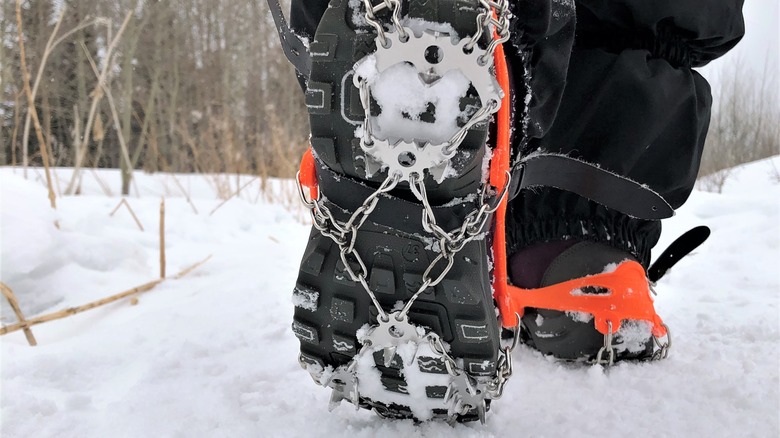
Life is like a dream/Shutterstock
In extreme cases of winter weather, you might want to opt for spiked boots. For more than a century, mountaineers have used them to dig into walls of ice and hold themselves in place. Crampons have become standard equipment for winter climbers, particularly mountaineers or ice climbers. Few of us require metal knives sticking out of our footwear, but “traction cleats” work on the same principle: stabilize your feet on frozen sheets by digging into the ice.
Traction cleats are like tire chains for your boots, an elastic web of metal rings or studs that straps easily over your heel and toes. Brands like Yak Tracks add extra tread to your boot, making it difficult to slide on sheer surfaces. Traction cleats are ideal for very cold conditions when the trail is glazed in ice, and winter hikers can avoid ankle-twisting falls that could put them in a dangerous situation. Traction cleats are so effective that many commuters in cold climates use them on regular sidewalks. If you’re looking for better traction when hiking on snow but aren’t sure you want heavy-duty crampons, microspikes on the bottom of your shoes should be able to help.
Dress in layers
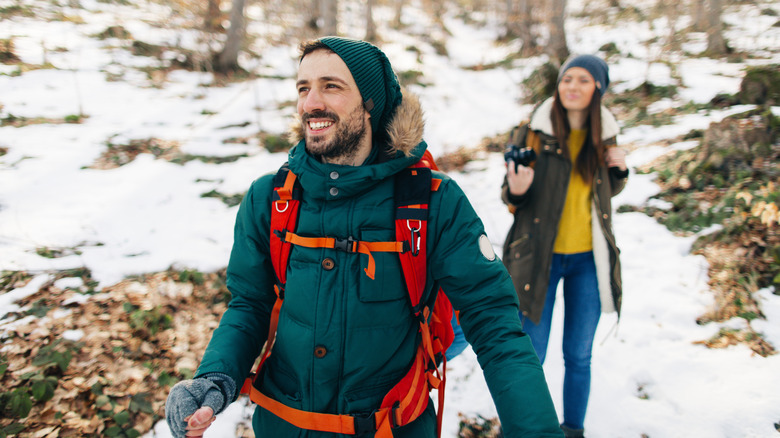
Aleksandarnakic/Getty Images
Hiking is physical work, which often means sweat. Since your goal is to stay warm, a little perspiration may seem like a good thing, but it’s very much the opposite: Once you stop moving, sweat will rapidly cool your body. The same sheen that comes as a relief on a hot day can make you feel extremely cold in the winter.
Retaining body heat is still important, but instead of throwing on one giant coat, consider wrapping yourself in several layers. Most winter hikers use a base layer, such as long underwear, then an insulating layer (sweater or fleece), and finally a shell, like a strong jacket, to protect against wind. As you exercise, you can remove your insulating layer to prevent overheating, then put it back once when you pause. Seek out fabrics that “wick” moisture. Hoods are also handy, especially on blustery days. Seasoned hikers usually bring backpacks or other types of bags so that when they strip a layer away to regulate body heat, they can store the item until it’s needed again.
Protect your face
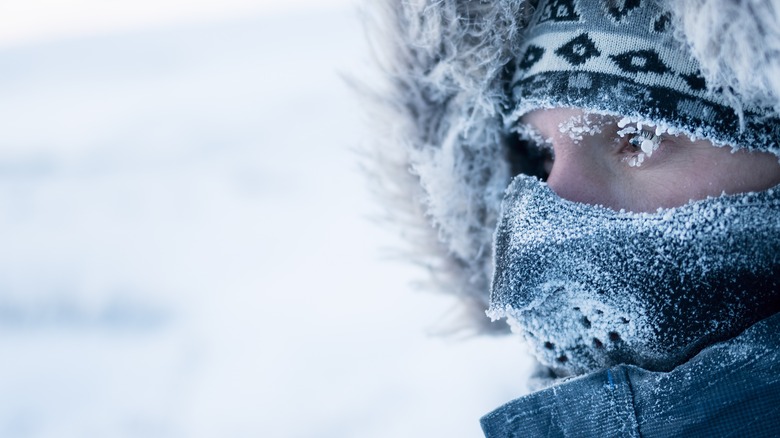
Andrei Stepanov/Shutterstock
Our cheeks are the most common victims of “frostnip,” the painful precursor to frostbite, because people often don’t think to cover their faces when venturing outside in the cold. Cold weather and strong winds can wreak havoc on your face, from a prickly sensation to skin inflammation and worse.
Many varieties of headgear, starting with traditional wool hats and scarves, may just do the trick. But you may also try a balaclava, a thin mask that covers the head and face and leaves only an opening for the eyes, or a neck-gaiter, a loose circle of fabric that wraps around the jaw or cranium, depending on which is colder. In heavy winds, you may even consider a pair of snow goggles, which can protect the eyes from stinging blasts. As with any layers, while exercising, you’ll want to avoid garments that are too warm, as sweat can make you feel even colder.
Use trekking poles
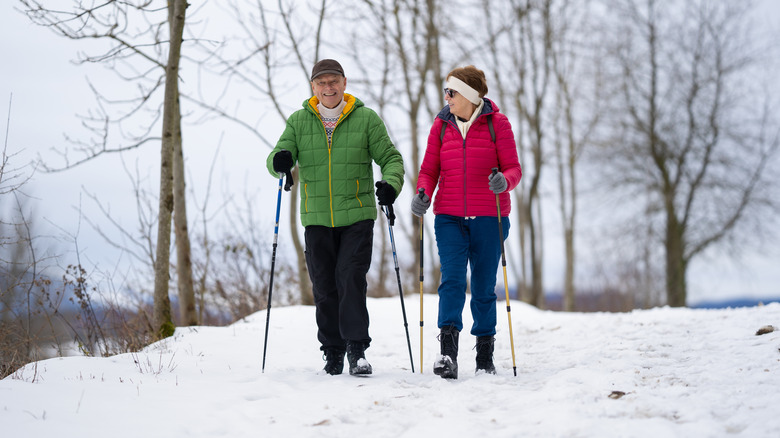
Amriphoto/Getty Images
Trekking poles are basically ski poles that have been redesigned for hikers — like a more practical, retractable version of a walking stick. Once you try them on a steep slope, you may never go back. Trekking poles help hikers balance themselves over rocks and ice, and you can lever yourself up rocky ledges. You can tap surfaces to test their stability. You can lean into them when you’re tired, especially when you’re carrying a heavy backpack. There’s everything to love about a pair of trekking poles, and many serious mountaineers swear by them. They’re especially helpful for older hikers, inexperienced hikers, people with balance issues, and hikers on a long-distance journey.
It may seem counterintuitive for such a helpful tool, but the poles actually give you a better workout. Hikers exercise their upper bodies as well when they use them, burning an estimated 20 percent more calories in the process. While many hikers want to retain energy for long expeditions, others are trying to get fitter and maybe lose weight, and trekking poles are a step in the right direction.
Bring emergency gear

Miguel Perfectti/Getty Images
An hourlong walk in the park shouldn’t pose much danger, no matter how much snow coats the ground. But as your hikes get longer and the terrain gets more complex, the more possible it is that something will go wrong. As a rule, fewer people hike in the wintertime, which means there are fewer people to help a hiker who is injured or trapped somewhere. Snow absorbs sound waves, making it more difficult for people to hear each other. It should be noted that doing any physical activity in the winter is generally more strenuous than in warmer temperatures, and you’re likely to tire out much faster, especially when your body is covered in heavy layers and gear. The cold can make a bad situation much worse.
Ideally, a hiker will bring company and inform others of their whereabouts, but you may also bring a few basic items for emergencies. Some handy accoutrements include a first-aid kit, a whistle, some extra food, and bright clothing. For longer hikes and overnights, you may consider a fire-making kit, a headlamp, and even a “bivvy bag” or survival blanket.
Drink water
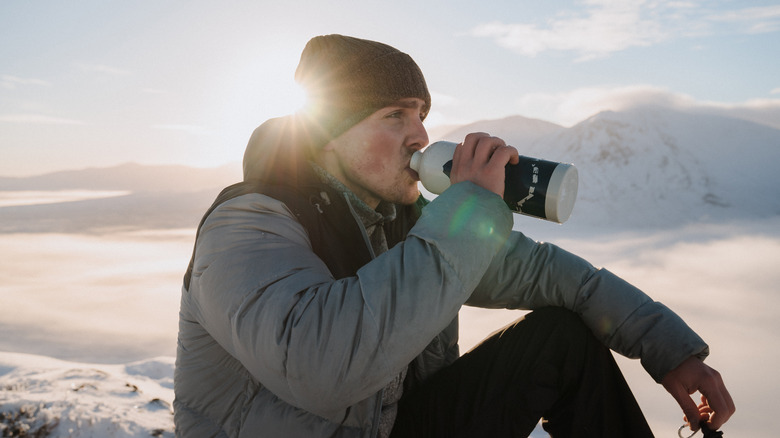
Ascentxmedia/Getty Images
On a hot day in the middle of summer, it’s easy to remember to drink water. Most of us feel thirsty, and intense sun and heavy perspiration are firm reminders that water is necessary to keep our bodies functional. But hikers are more likely to forget to replenish liquids in the winter, which can cause serious problems down the path. Hydration is an essential part of exercise, whether you feel parched or not, and most adults should drink between 11 and 16 cups per day.
Most hikers bring reusable bottles, such as Nalgene containers. Remember that cold temperatures will keep water cold as well, and there is always the possibility that your life-saving liquid will freeze. Specialty water bottles will keep your water at a certain temperature for longer, If you’re planning to camp out, you’ll want to make sure you have access to fresh water, either from a spigot or by purifying from a natural source. This can be challenging in certain places, where plumbing may get shut off and ponds and streams can be iced over.
Consider snow shoes or skis
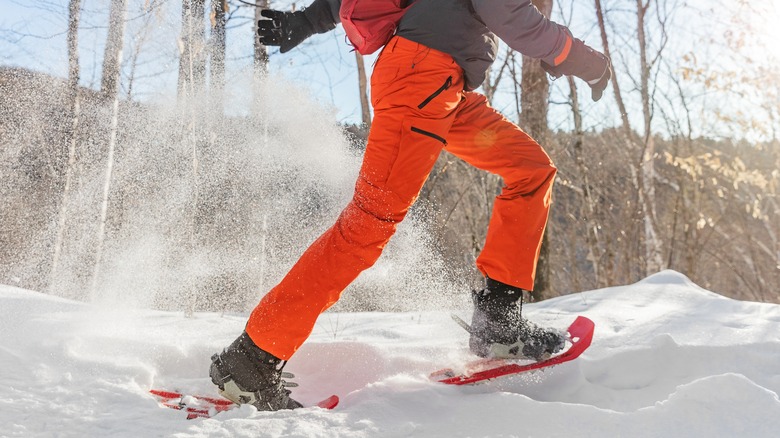
Maridav/Shutterstock
Naked human feet have never fared well in the snow, and even the best boots can be a drag when the powder is thick enough. There’s a reason skis were invented: They glide over the surface and prevent you from sinking into the bluffs. Scandinavians have been cross-country skiing for several hundred years, and many believe that the concept dates back to prehistoric peoples. If cavemen were smart enough to use skis to get around snowy terrain, there’s every reason that modern hikers should give it a try.
Most of us can find downhill ski slopes in any mountainous state, but compelling cross-country can be harder to pin down. If you’re keen to try, you can look for an ideal cross-country skiing destination.
If the motion of cross-country skiing feels unnatural — or at least uncomfortably different from hiking — you may enjoy snowshoes instead. The wide platforms are often made from woven string or frames of aluminum and plastic, and they also keep your body buoyant in thick snow. The concept behind snowshoes is also thousands of years old and helped Neolithic hunters march across the tundra in search of game. Using this specialized footwear does feel strange at first, but most people adapt quickly.
Know your limits
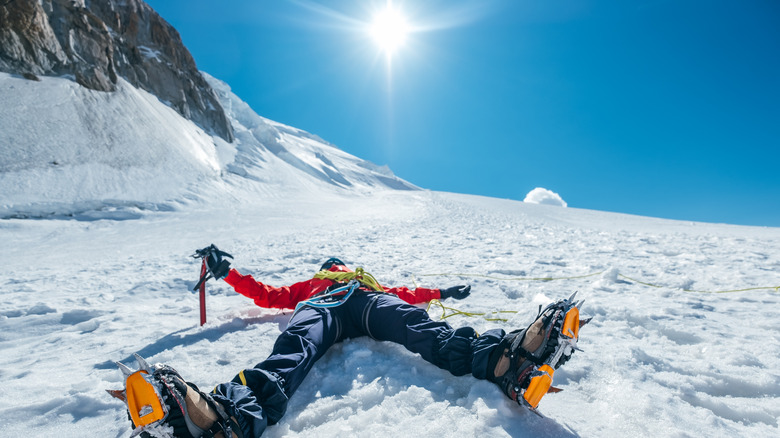
Solovyova/Getty Images
No matter what the season is, you should always know your limits. Reaching the top of a mountain is never as important as staying safe. Many outdoorspeople, including famous Arctic explorers, have gotten themselves into serious trouble by underestimating the climate or overestimating their own abilities. One of the most famous cautionary tales is that of Capt. Robert Falcon Scott, whose overreaching attempt to reach the South Pole ended in his party freezing to death in the barren planes of Antarctica. Closer to home, there are more than 30,000 members of the National Ski Patrol, which gives you a sense of just how many people are needed to keep people safe just on ski hills and other ski and snowboarding areas, never mind parks and wilderness areas. Isolated mountain climbing in the winter can be unforgiving, and there’s a major difference between challenging yourself physically and biting off more than you can chew.
If you’re new to hiking in the snow, the best advice is to start simple and gradually take on longer and more complicated routes. As you adapt to the cold and the difficult footing, you’ll also learn the many types of snow and the unique pleasures they bring. It really is as simple as putting one foot in front of the other.

